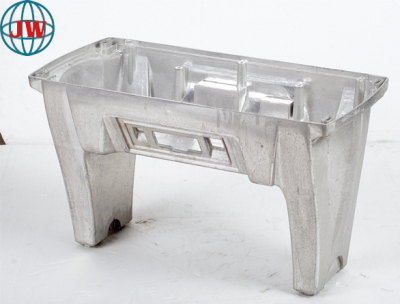
Trends Shaping the Future of Aluminum Die Castings in Furniture Industry
2025-07-24 15:30
In the ever - evolving landscape of furniture manufacturing, aluminum die castings have emerged as a game - changing element. As consumer demands and technological capabilities shift, several notable trends are steering the course of aluminum die castings in the furniture sector.
Design Innovation: Pushing the Boundaries of Aesthetics and Function
One of the most prominent trends is the pursuit of innovative designs. With the help of advanced CAD (Computer - Aided Design) and simulation software, designers can now create highly intricate and unique furniture pieces using aluminum die castings. Complex geometric shapes, organic forms, and modular designs that were once difficult or impossible to achieve with traditional manufacturing methods are now becoming a reality. For example, some high - end furniture brands are producing chairs with flowing, sculptural legs made from aluminum die castings. These not only provide a strong and stable base but also add a touch of artistic elegance to the overall design.
Moreover, the trend towards multifunctional furniture is also being facilitated by aluminum die castings. Components such as adjustable joints, hidden storage mechanisms, and fold - out parts can be precisely engineered as die - castings. This allows furniture to adapt to different user needs and space requirements. A coffee table with die - cast aluminum hinges that enable it to expand into a dining table or a sofa with detachable and reconfigurable armrests made of aluminum die castings are prime examples of this trend.
Sustainability: A Green Revolution in Furniture Production
Sustainability has become a core consideration across all industries, and the furniture sector is no exception. Aluminum, being highly recyclable, is at the forefront of the sustainability drive in furniture manufacturing. The use of recycled aluminum in die - casting processes is on the rise. Manufacturers are increasingly sourcing post - consumer and post - industrial aluminum scrap to produce die - cast furniture components. This not only reduces the demand for virgin aluminum, which requires significant energy to extract from bauxite ore, but also helps in diverting waste from landfills.
In addition, the lightweight nature of aluminum die - cast furniture parts contributes to lower transportation emissions. Since furniture often needs to be shipped long distances from manufacturing facilities to retailers and end - users, the reduced weight of aluminum - based piecesmeans less fuel consumption during transportation. Some furniture companies are also implementing energy - efficient practices in their die - casting operations, such as using advanced insulation materials in furnaces and optimizing the die - casting cycle times to minimize energy waste.
Material Advancements: Enhanced Performance and Durability
New alloy formulations are being developed to further enhance the performance of aluminum die castings in furniture. These alloys are designed to offer improved strength, corrosion resistance, and heat resistance. For instance, alloys with added magnesium and silicon can significantly increase the tensile strength of aluminum die - castings, making them more suitable for heavy - duty furniture applications like industrial - style tables or large - scale office furniture.
Moreover, advancements in surface treatment technologies are expanding the possibilities for aluminum die castings. In addition to traditional anodizing and powder coating, new techniques such as electrophoretic coating are being adopted. Electrophoretic coating provides an extremely uniform and durable finish, enhancing the furniture's resistance to scratches, abrasion, and environmental factors. This is particularly important for outdoor furniture, where aluminum die - castings need to withstand harsh weather conditions.
Industry 4.0 Integration: Smart Manufacturing for Higher Efficiency
The integration of Industry 4.0 technologies is revolutionizing the production of aluminum die - cast furniture components. Automation and robotics are being increasingly used in the die - casting process. Robots can precisely handle molten aluminum, pour it into molds, and remove the finished castings, reducing human error and increasing production speed. Automated quality control systems, using technologies like machine vision, can quickly and accurately detect any defects in the die - castings, ensuring a higher - quality end - product.
Furthermore, the implementation of the Internet of Things (IoT) in die - casting facilities allows for real - time monitoring and control of the manufacturing process. Sensors can be placed on equipment such as furnaces, die - casting machines, and cooling systems to collect data on temperature, pressure, and energy consumption. This data can then be analyzed to optimize the production process, predict maintenance needs, and improve overall efficiency. For example, if a sensor detects that the temperature in a furnace is fluctuating outside the optimal range, the system can automatically adjust the heating elements to maintain the correct temperature, reducing the risk of defective castings.
Customization: Meeting the Individual Needs of Consumers
Today's consumers are increasingly demanding personalized products, and the furniture industry is responding. Aluminum die - casting, with its flexibility in design and production, is well - positioned to meet this trend. Manufacturers are leveraging technologies such as 3D printing for rapid prototyping of custom die - casting molds. This allows them to quickly create unique molds for one - off or small - batch production of customized furniture components.
Customers can now request specific shapes, sizes, finishes, and even incorporate their own design ideas into the furniture. A homeowner might want a set of custom - designed aluminum die - cast drawer handles for their kitchen cabinets, with a unique pattern or color. Furniture manufacturers can use digital design tools to translate these ideas into physical products through the die - casting process, providing a level of customization that was previously difficult to achieve on a large scale.
In conclusion, the future of aluminum die castings in the furniture industry is bright and full of potential. With continuous innovation in design, a strong focus on sustainability, advancements in materials and manufacturing technologies, and the ability to offer customized solutions, aluminum die castings are set to play an even more significant role in shaping the furniture of tomorrow.
Get the latest price? We'll respond as soon as possible(within 12 hours)












